SPINIFEX LANDSCAPE, HAMERSLEY RANGES, 1979
FRED WILLIAMS
gouache on paper
55.0 x 75.0 cm
signed lower left: Fred Williams.
bears inscription verso: SPINIFEX LANDSCAPE, HAMMERSLEYS [sic.] / 1979
Estate of the Artist, Melbourne
Mrs Lyn Williams, Melbourne
Rex Irwin Art Dealer, Sydney (label attached verso)
Private collection, Sydney, acquired from the above in 1989
Some Aspects of the Work of Fred Williams, Rex Irwin Art Dealer, Sydney, 15 August – 2 September 1989, cat. 24
The lands that form the Pilbara region in north-western Australia are ancient and rich with minerals. Residing at Karratha Station in 1979, a country property fifteen kilometres from the coast, Williams was well placed to survey the rugged outline of the Hamersley Range. He studied with exhilaration the nuances of its distinctive landforms and unique flora, adapting his distinctive visual language to the particularities of this specific Antipodean landscape. Williams felt an immediate and profound engagement with this landscape, producing dozens of gouache paintings outdoors with the spinifex grass scratching his ankles.1 Spinifex Landscape, Hamersley Ranges has a high horizon line dotted with distinctive Kimberly boab trees, which reinforce the divisions of Williams’ favoured tripartite composition of horizontal strips. His horizon buckles under an enormous expanse of blue sky, his segmented landscape sparkling with mineral deposits and interspersed with scrubby native spinifex hummocks and wildflowers. Spinifex Landscape, Hamersley Ranges is characterised by touches of paint and lines laden with pigment set against bands of sweeping wash, evoking the overwhelming vastness of the artist’s vista of this primeval landscape.
Fred Williams had been invited by the chairman of the mining company CRA (now known as Rio Tinto), Sir Roderick Carnegie, to visit the Pilbara region. Carnegie, a family friend of the Williams, had been impressed by the artist’s recent aerial paintings of mining operations at Weipa in Queensland and invited him to compare this experience with the awe-inspiring scale and raw elemental power of the Pilbara. Based on visual material gathered during two consecutive trips, Williams produced a remarkable body of work, twelve landscape paintings and a large number of gouaches all painted in situ. These Pilbara paintings were to become his last series – twelve months after their completion, in April 1982, the artist passed away.
Patrick McCaughey, in his monograph on Fred Williams, explained that while CRA made no formal commission for the creation of these landscape paintings, there was ‘a vague idea that he [Williams] should record the Pilbara before it was changed by the effects of mining’.2 Flying over the region in a biplane and taking hundreds of photographs, Williams desperately sought to capture the nuances of this foreign landscape, then using the fast-drying medium of gouache to faithfully and immediately transcribe its saturated minerally rich colours. Gouache enabled the creation of a wider range of textures, from thick daubs to wide washes, handled with fluidity and mature confidence.
Spinifex Landscape, Hamersley Ranges, is one of the gouaches painted either in situ or in a flurry of activity immediately upon the artist’s return to Melbourne. Williams was so impatient to fix the images onto paper that it was only in March of 1981 that he returned to the subject to execute a final series of landscapes in oil – all these paintings were eventually acquired by CRA (and subsequently donated to the NGV) along with eighteen of the gouaches, many others being purchased by the National Gallery of Australia.
1. Hart, D., Fred Williams. Infinite Horizons, National Gallery of Australia, Canberra, 2011, p. 177
2. McCaughey, P., Fred Williams 1927 – 1982, revised edition, 1996, Murdoch Books, Sydney, p. 321
LUCIE REEVES-SMITH
